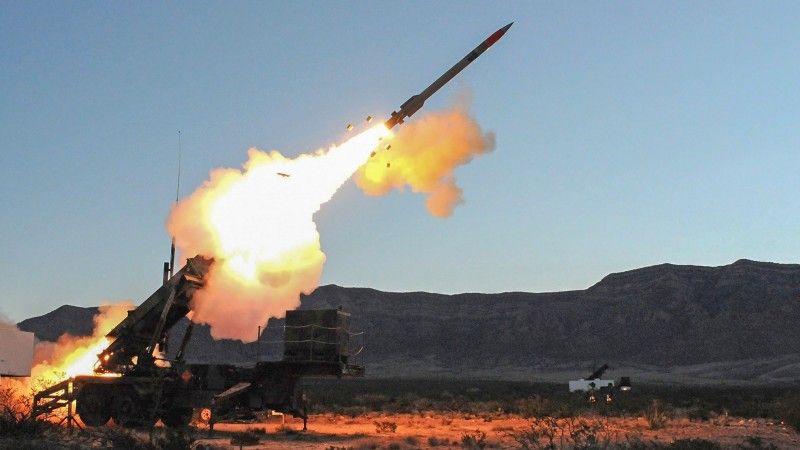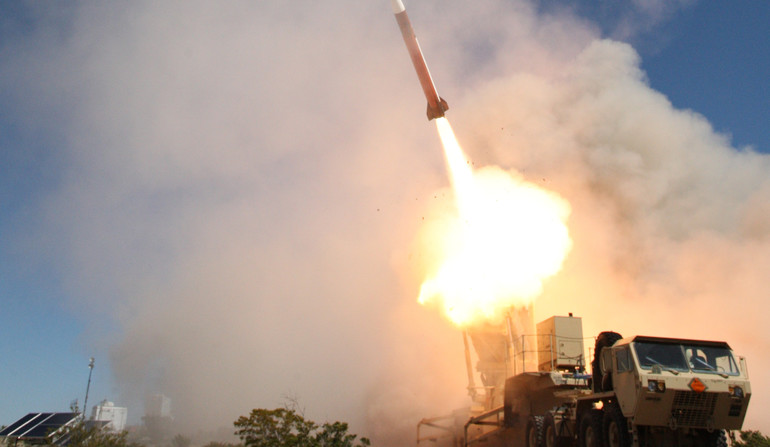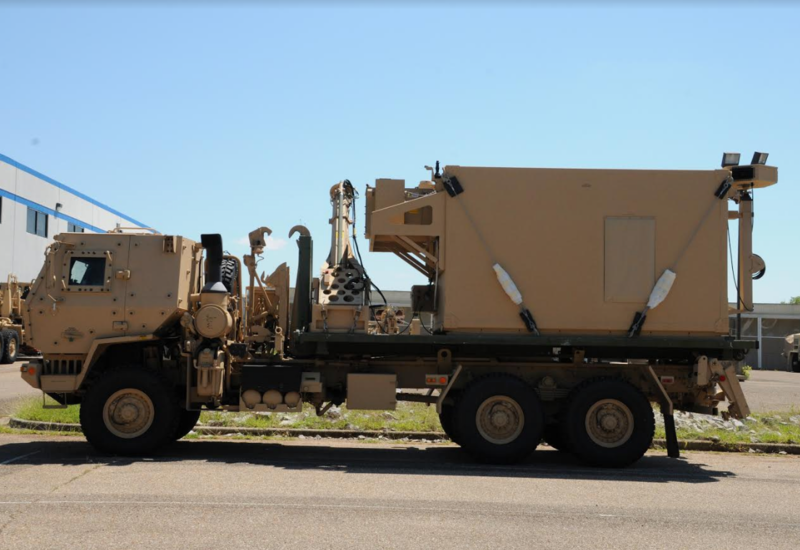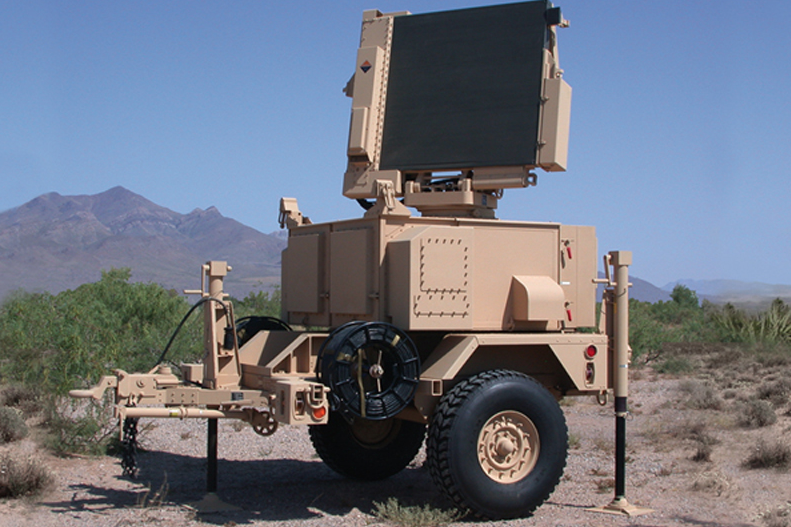Industry
Northrop Grumman: A Payload Approach for IBCS in Narew SHORAD Enhances Polish Industry Participation

In an interview with Defence24.pl William Lamb, director, Multi-Domain Mission Command operating unit, Northrop Grumman discusses the opportunities of the potential use of IBCS system in Polish Narew SHORAD project, including the Polish industrial participation and the „payload” approach of Northrop Grumman for Narew. Also, the recent IBCS tests are discussed as well.
Jakub Palowski: IBCS has just started a Limited User Test in White Sands, New Mexico. What is the significance of this test? When could IBCS move from EMD phase, to the production phase?
William Lamb, director, Multi-Domain Mission Command operating unit, Northrop Grumman: The Limited User Test is a critical operational test, comprised of several tests, and intended to simulate realistic warfighting operations. It will place extraordinary performance stresses on the systems to ensure it will perform as intended and under the most rigorous circumstances once deployed.
We are supporting the U.S. Army during the execution of the LUT since testing was initiated in early July. The testing is scheduled to run till the middle of September. The scope of the testing involves hardware in the loop, live air testing, and two live fire tests that are forecasted in the August timeframe. LUT is a test independently planned and executed by the Army, where trained soldiers will employ the system in a real environment, against very realistic threats.
A successful IBCS LUT means that the U.S. Army will have essential information needed to make a decision for the program to enter into Low Rate Initial Production (LRIP) and deployment. The Milestone C decision, which will allow the IBCS to enter LRIP, is foreseen to take place sometime later this year.
Are you confident that IBCS will meet the current schedule of achieving the Initial Operational Capability? Did COVID-19 pandemics affect fielding of IBCS in any way?
Despite the COVID-19 pandemic, the program remains on track in all aspects, from software development and testing to training, and field support. We have full confidence in the IBCS system and that it will deliver the functionality and features as intended and designed.
Since March, our Northrop Grumman program team has been on the ground at White Sands Missile Range, New Mexico providing soldier training, system technical assistance, and logistics and field service support to the test unit undergoing testing. Our Wisła program has also remained on schedule and will enter into production later in the year.

Before the Limited User Test, IBCS has went through several tests including live firing and cooperation with sensors from other Services. How could those test prepare IBCS to the LUT that is taking place now – and for a potential production start?
Over the past year, the program has achieved several major milestones in development and testing. We conducted two successful developmental flight tests in August and December of 2019. IBCS’s transformative capability was demonstrated in FT-04 in August 2019 with successful engagement of a cruise missile and achieved the longest fly out and intercept by a PAC-3 missile. This was enabled by a network architecture that enabled Sentinel Short Range radars to acquire the cruise missile and enable an IBCS engagement, at a range beyond where the Patriot radar could see.
Another groundbreaking achievement was made during FT-05 in December 2019 where IBCS successfully demonstrated the simultaneous engagement of two cruise missiles based on a network architecture that included two F-35s and integration of their sensors with the IBCS network.
Both these tests contributed to a body of development testing that demonstrated IBCS system maturity and its readiness to undergo independent operational testing as a part of the Limited User Test on-going at White Sands Missile Range.
What are major improvement areas regarding IBCS, when we compare system to the previous testing in 2016, which resulted in rescheduling of the system deployment and fielding?
The 2016 LUT was the first operational test of IBCS, and lessons learned then have resulted in a substantially improved system. Since the 2016 LUT, the IBCS Engagement Operations Center and Integrated Fire Control Relay have both undergone redesigns. In collaboration with the Army, we have also made significant improvements in the IBCS SW from a performance and reliability perspective, while also enhancing computing power. Since 2015, the Army and Northrop Grumman have conducted five for five successful flight tests culminating in intercepts of complex, threat representative targets. These tests, exercises and more have provided excellent feedback and data to drive significant performance improvements throughout the development process of the IBCS program. They have demonstrated that the program’s objectives are achievable, the system architecture is sound and that the system is mature.
IBCS is said to be developed using the Agile Software Development Framework. Why this methodology was introduced and what are the benefits to it?
The Agile Software development approach is an adoption of industry practices toward enabling system and software development to be performed at an accelerated pace in order to deliver and field new systems and capabilities sooner. Over the past year, Northrop Grumman, in partnership with the U.S. Army has implemented Agile processes and is already seeing the results. IBCS software being tested in LUT was developed in Northrop Grumman’s Agile software development factory.
Through the implementation of Agile, our software development teams can accelerate and advance the system’s development toward enabling earlier testing and fielding of capabilities faster to respond to current and emerging needs and rapidly bring innovative solutions to the warfighter. Agile methodology enables regular communication with our Army customer and to get feedback from Army soldiers early on in the process which helps address any issues.
The most current IBCS testing, like that one in December 2019, did include not only Patriot and Sentinel radars, but also various other sensors including F-35 fighter aircraft. How could integration of those assets enhance the Integrated Air and Missile Defence architecture, which is based on IBCS?
As an open systems, network-enabled system, IBCS’s integration with F-35 is truly transformative from an air and missile defense perspective and from a Multi-Domain Command and Control (MDC2) perspective. By integrating F-35, the IBCS program has demonstrated the capability for airborne sensors to contribute to the development of a Common Operating Picture (COP) that enables the engagement of threats that might not be detected or tracked by ground sensors. Further, the F-35, through its contribution to creating an IBCS network track, improves the air picture, extends the battlespace, and enhances total system performance in defeating air and missile threats.

Is there any currently USG-approved requirement to integrate those sensors (i.e. beyond Patriot, Sentinel and THAAD), into IBCS?
We are cognizant that The Army is continuing to develop future requirements for integration of Army and Joint Forces sensors. The system’s Modular Open System’s Approach (MOSA) architecture enables this level of integration which is affordable and can be achieved on a significantly reduced timeline than non-MOSA based systems designs.
US Army is planning to introduce its own Short Range Air Defence system, named IFPC Inc-2I, and various missile systems are being considered to for that system. Have you engaged in any discussions regarding integration of IBCS with some of the effectors that can be used in the IFPC Inc 2I?
IBCS is the centerpiece for the U.S. Army’s modernization strategy for Integrated Air and Missile Defense. As a part of their strategy, we understand the U.S. Army plans to integrate new sensors and effectors like IFPC to enable the vision of a single C2 system for all of U.S. Army Air and Missile Defense.
What I can say based on the publicly available information is that the US Army is planning a “shoot off” sometimes next year, and once the Army will decide which system is to be chosen for an enduring IFPC solution, it will be placed on a modernization roadmap for the integration into IBCS.
US Army is currently introducing an Interim-Maneuver SHORAD using the existing FAAD C2 system. Do you think that IBCS, in the future, will also be able to integrate more mobile systems such as Maneuver SHORAD? And will IBCS be included in the Objective Maneuver SHORAD of the US Army?
FAAD C2 will be integrated into IBCS. FAAD C2 is one of the systems that is on the US Army planning roadmap for the integration into IBCS. The timing of that integration has not yet been defined. We have to defer to the US Army for specifics of timing of that integration effort.
As of today, the cooperation efforts of the units using IBCS-componentized systems and those using FAAD C2 would be using Link 16. There is a difference between the use of Link 16 and the true integration directly into IBCS, as the former is more about sharing the Common Air Picture, while the latter means tying directly into the IBCS network, so the elements of the system constitute the actual elements of Integrated Battle Command System network. So, referring to your earlier question, while IFPC will be directly integrated into IBCS, FAAD C2, at least initially, will cooperate with IBCS through Link 16.
In Poland, besides Wisła and Narew, there are various projects regarding the mobile VSHORAD Air Defence, like Poprad and Pilica. So how would they cooperate with IBCS?
IBCS, as a program, has a specified requirement for being able to extend the network over a certain, quite substantial distance. If you are operating within that distance as a Short/Very Short Range Air Defence System, you should be capable of receiving a shared air picture created by the IBCS.
In order to do that, one needs to be able to link in. Today, it would take place through Link 16. In the future, if there is a decision to integrate the VSHORAD systems directly into the IBCS so that they could become the elements of IBCS network, there is an appropriate capability in the systems’ architecture.
In the United States there are lots of discussions on the Joint All Domain Command and Control (JADC2). To what extent IBCS could participate in the JADC2 system? And do you see IBCS as a system that could integrate the Air Defence with other units, such as Field Artillery or the Tactical Aviation?
IBCS, as a MOSA, network-enabled, software-designed system, can play a critical role in emerging JADC2 capabilities. The architecture at the foundation of IBCS is capable as serving as a major component of a JADC2 system architecture to connect the all-domain battlespace. Through its demonstrated capability to integrate sensors and effectors across multiple domains, IBCS has the capacity to be extensible to integrate with other networks and C2 capabilities.
As such, Northrop Grumman anticipates that in the future, investments will be made to develop and broaden the IBCS architecture to further enable multi-domain operations and contribute to enhancing capabilities like long-range precision fires.
What role could IBCS play if a joint offensive-defensive fires doctrine, considered in the US now, would be implemented?
Thinking around the role that IBCS could play in joint-offensive and defense fires remains very formative, but there is recognition that enhancing those capabilities requires the kind of network architecture and sensor/effector pairing that IBCS is capable of today.
Let us move a bit towards Poland and Europe. IBCS is being offered for Narew as well as for Wisła Phase 2. How would you like to ensure the Polish industrial participation in both projects, as it is foreseen to be increased, when compared to Wisła Phase 1?
Should IBCS be selected as the C2 for Narew, Polish industrial content will be substantive. Our approach encompasses what we characterize as a payloads approach. An IBCS payload will consist of the network equipment (computers, servers, routers) and software required to create the network of capabilities that IBCS is built on.
Polish industry will design, and manufacture the command centers and communication relay components of the architecture. With the exception of the IBCS payloads, Polish industry will manufacture and deliver the major components and end items of the Narew system. This will include trucks, shelters, radios and communications equipment associated with the command centers and communications relays equivalents (titled Mobile Communication Centers). All those elements would be manufactured and assembled in Poland, by Polish industry.
Additionally, the Northrop Grumman approach will be to install the IBCS payloads and perform system checkout in Poland working in conjunction with the Polish industry, so it would be substantially different to what we are seeing in Wisła Phase 1. And a similar approach could be chosen for Wisła Phase 2, should the Polish Ministry of National Defence take such a decision.
Further, in addition to the significant manufacturing content, we plan to engage with Polish industry on the integration of Polish manufactured sensors and, when selected, a new effector. This will involve software development work by Polish industry to integrate those systems with IBCS. Our intention is that the Polish industrial content be substantive from a hardware and software perspective. This will all enable both Wisła and Narew sensors and effectors to be employed in one single integrated command and control network that will be fully interoperable with U.S. forces. So there is a significant Polish industry content in Narew, and there is support for that configuration from the US Department of Defense, should IBCS be selected for the Narew acquisition.

Have you already started any efforts to integrate the Polish sensor, like the long range P-18PL, the passive PCL-PET, or the short range Bystra radars?
First of all, I would like to reinforce that the architecture of the system affords that level of integration of the mentioned sensors into the IBCS. The offset agreement within Wisła project are closely associated with technologies related to integrating the Polish sensors into IBCS. This is the A-side integration, where the Polish industry would receive know-how on how to develop software and hardware for the integration of sensors you mentioned.
With respect to the Ministry of Defence plans and the scope of Narew and Wisła phase 2, there is certainly an interest in doing the integration of Polish sensors, but there is no work that we are doing today to deliver that. Ever since IBCS in US Army configuration was selected as Wisła Phase 1 C2 system in March 2018, we have been committed to providing this capability to Poland. We are confident that we can deliver the system according to schedule. We have not been contracted to conduct integration of a Polish sensor.
The Offset Execution agreements for Wisła Phase 1 have not been signed yet. Do you see a risk to the Phase 1 schedule due to the delays?
The delays in completing the offset execution agreements are unfortunate, but they will not impact production and delivery of Wisła. We are, however, increasingly concerned with their impact on Narew program execution should IBCS be selected for Narew. Our Wisła Offset projects will provide training and technology transfer that will enable the kind of transformative development initiatives that will enable Polish industry to integrate Polish sensors and effectors with IBCS.
In Poland there are some concerns regarding the IBCS mobility, particularly when referring to Narew, as the system will need to be deployed in close proximity to combat zones and will need to be capable of frequent and quick relocations, so the elements of the systems would likely have to be installed directly on vehicles. Are you making any changes to the system, to increase its mobility to satisfy the Polish requirements?
Today, we are not doing any work for changes of the system employment regarding the Wisła Phase 1. Based on the scope and the requirements for Narew we recognize that there could be a move from the configuration which is currently purchased for Wisła, but that lies within the Narew program, where the Polish Ministry of Defence has not yet made a decision on the Command and Control System. A similar payloads configuration to one I described for Narew could also be used for Wisła Phase 2, should the Polish Ministry of Defence make such a decision.
How can Polish industry benefit from cooperating with Northrop Grumman on IBCS in Narew? Do you see increased interest from other international partners? And can Poland play a role in future exports of the system?
We welcome opportunities to partner with Polish industry on the sale and delivery of capabilities to Poland and also more globally in the growing market for Integrated Air and Missile Defense and Multi-domain C2. We have actively engaged Polish industry around the potential for these relationships and remain hopeful, that should IBCS be selected for Narew, that the program affords opportunities for industry teaming and collaboration.
As you know, Poland is the first country to acquire IBCS and through its acquisition, has contributed to the significant interest the program is seeing from other countries. The FT-05 development test was attended by Poland and representatives from five other countries.
Can you reveal which countries, besides Poland, have attended that test?
I cannot name any specific country besides Poland. With respect to your question, however, I would like to frame it that way: Poland and the Ministry of National Defence have recognized very early the transformational capability that IBCS affords. And when you look at Patriot modernization across the globe, there are more than 15 countries that have acquired or are acquiring the Patriot system.
In terms of modernization, over the last several years the modernization has been through the acquisition and integration of PAC-3 MSE missiles. Today, with IBCS reaching the development and fielding, it now represents the next stage, where countries can modernize the Patriot systems they already have. And because of the architecture of the IBCS affords that level of integration, it is very attractive for countries to be able their own indigenous sensors or otherwise the capabilities they already have. And that is why I think IBCS is an appropriate command and control system for Narew.
I would also like to ask about the cost. We heard from the publicly available statements that IBCS comprised about 15% of the Wisła Phase One system cost, which was $4,75 billion in total, so IBCS contract for Phase I was worth $713M. Taking into account the number of batteries planned for Narew, likely more than a dozen, the cost of IBCS could be substantial. How could you comment on that, can Poland capitalize investment made in the IBCS in Wisła Phase One in any way? And what about the life cycle cost?
It would be premature to provide a comparative assessment of costs given the complete scope of Narew has not been defined nor underpinned by an agreement between the Governments of Poland and the USA. We can assert that given the IBCS payload approach we have proposed, the procurement costs for IBCS for Narew, on a per unit basis, will be substantially lower than for Wisła. As I have mentioned previously, our proposed approach to Narew is to deliver the network equipment (servers, routers, etc.) with IBCS SW for installation into Polish manufactured command, operations, and communications centers. The installation will be performed in Poland in support of Polish industry. The procurement cost for IBCS therefore will be comparatively small as all the trucks, shelters, generators, communications etc. for NAREW will be acquired and manufactured by Polish industry.
With respect to lifecycle costs, from inception, IBCS, by virtue of its Modular Open Systems Approach architecture, was designed to achieve lower lifecycle costs. This was a significant focus of the U.S. Army as it sought to eliminate multiple, stove piped Air and Missile Defense command and control systems and replace them with one which is IBCS. Should Poland decide to select IBCS for NAREW, total life cycle costs will be lower by virtue of having a single command and control system and software vice two separate systems should Poland select another C2 system. For instance, training costs will be lower as a soldier would train on one command and control system vice potentially two or more or systems. Further, the ability to affordably modernize and integrate new capabilities to address evolving threats, is enabled by IBCS’s open systems design. Finally, with respect to leveraging Poland’s capital investment in WISLA, we anticipate that there will be cost synergies, both from a software sustainment perspective as I have described, but also by virtue of leveraging organization and physical infrastructure underpinning the WISLA program.
Thank you for the conversation.
